New York Yankees championship series begins with 1928 and Babe Ruth

The Yankees have won more championships in years that end in eight than any other. Today starts the first of five Saturday articles looking at those great teams, starting in 1928. And a catch that the Babe was prouder of than the three home runs he hit in that same World Series finale, one that had manager Miller Huggins crying.
The New York Yankees are the biggest winners in sports.
And they have won more of their remarkable 27 World Titles in years that end in eight than any other: 1928, 1938, 1958, 1978 and 1998.
As this year ends in the same number, and the Yankees look like serious and scary World Series contenders once again, we thought it was a good time to look at the teams that made them the Bronx Bombers.
The 1928 Yankees turned out to be a great team to start this series with. One reason, of course, is that it features baseball’s irrepressible GOAT, Babe Ruth. With all due respect, there ain’t no party like a Babe Ruth party ’cause a Babe Ruth party don’t stop; you’ll see.
But there are also several noteworthy links to both the 1978 and current Yankees’ squads, as well.
And Here We Go
First, though, a quick question: Which is the greatest baseball team of all time? Not just Yankees, but all of baseball. While there is room for some debate, the answer most often given is the 1927 Yankees.
And why not, as its famed Murderer’s Row featured CF Earle Combs, RF Babe Ruth, 1B Lou Gehrig and LF Tony “poosh em up” Lazzeri. All four would go on to the Hall of Fame. And two are among the top ten offensive players of all time.
Facing them could not have been fun. For instance, Gil Troy at the Daily Beast related this quote from the Washington Senator’s 1B Joe Judge. This was after one particularly brutal series in July.
“Those fellows not only beat you but they tear your heart out. I wish the season was over.”
That sounds like something the Red Sox and Indians might be saying right about now. By the end, the stats spoke for themselves.
Collectively, the 1927 Yankees batted .307, had a record setting slugging percentage of .489, enjoyed great pitching seasons from Waite Hoyt (22-7, 2.63 ERA) and Herb Pennock (19-8, 3.00 ERA), and swept the Pittsburgh Pirates in 4 games in the World Series.
As you might imagine, that same group was back in 1928. But they achieved a greatness that even the ’27 team never could.
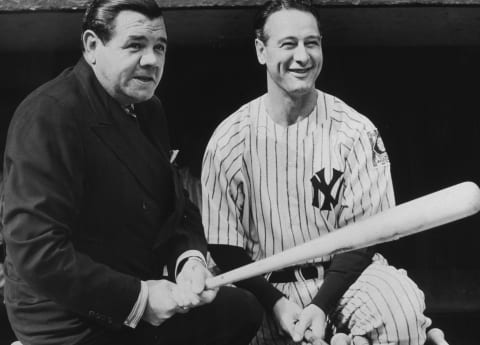
Seasons have Been and Always Will be Rollercoasters
The preseason did not go well for the ’28 Yankees. Regression and injury hinted at bad things to come. This increased hopes in the American League for a new AL and World Series Champion.
These were buoyed by the fact that no team had ever won the WS in back-to-back years.
None of that could be blamed on the Babe’s preparation, though. The fine prose by Paul Adomites and Saul Wisnia makes that clear.
As a side note, one of the joys of researching a piece like this is getting a chance to read great writers who have touched on this topic before. So, even though their writing makes a mockery of mine, I cannot but quote them liberally in their honor and yours, the reader.
Here is the first of many.
As had now become his regular off-season routine, Babe Ruth put himself under the brutal supervision of Artie McGovern for grueling daily workouts to get himself in shape for the 1928 baseball season. McGovern claimed, “Ruth is physically five to 10 years younger than he was two years ago [when they first began the workouts].” The Babe still indulged himself, but now in new pastimes like bridge, fox hunting (he could sweat off five pounds in one day on the horses), and the saxophone. It is known that he mastered one song; whether he ever learned a second is unknown.
Ruth’s efforts paid off, and the hopes of the rest of the league looked lost early, however. The Yankees got out of the gate quickly and looked like they might never stop.

Not Boston
Their biggest competition that year was a team in transition, the A’s; the Philadelphia A’s, of course. The teams would play in the two most important games of the year for both. And decide who would play the Cardinals in the World Series.
The first was played on May 24th. Although the date of the game makes the outcome somewhat irrelevant, it needs to be noted that there were no playoffs in 1928. You either won your league and advanced immediately to the WS, or your season was over.
That magnifies the importance of every direct match-up, especially when they are between the eventual first and second place finishers. Still, it is their late season set that ultimately proved decisive; we’ll get there soon.
No, what makes this late-May match-up so worthy of pausing at is that it featured more future HoF’ers than any game before…or since.
The First Order
The names of the men who played in this singular game are of giants who have passed into legend.
And their roll call resounds like the pealing of the bell at the first induction ceremony: Babe Ruth, Lou Gehrig, Ty Cobb, Tris Speaker, Lefty Grove, Jimmie Foxx, Combs, Lazzeri, Mickey Cochrane, Waite Hoyte, Al Simmons and Eddie Collins, he of the $100,000 infield two decades earlier.
Leo Durocher also appeared, but he’s in the Hall for his insightful managing. Bill Dickey was there, as well, but I believe he stayed on the bench. And here’s a little perspective just to be clear, this time brought by Jay Jaffe and Sports Illustrated.
He [Eddie Collins] finished his career with 3,315 hits. Alongside Cobb and Speaker, that gave these A’s three of the six members of the 3,000 Hit Club to that point.
And this as well.
Thus, this game featured what once ranked as four of the top five home run hitters, with Ruth (714), Gehrig (493) and Simmons (307). The only missing player was New York Giants legend Mel Ott (512).

And They Will One Day Leave for California
As you can imagine, it was the hottest ticket on Broad Street. And spectacle.
The Philadelphia Inquirer called the crowd of 42,000 “the largest baseball population ever recorded in Philadelphia history.” The New York Times estimated a total 45,000 “raving rooters” including those who swarmed over the rightfield fence and noted that the gates were locked long before the game’s start. “The fans were so packed in the aisles that they completely cut off all circulation of hot-dog salesmen. The fans perched in the rafters like blackbirds in a cherry tree,” wrote the Times‘ Richards Vidmer.
The outcome of the game is of little relevance. But the way in which the Yankees won finds links to the current men wearing those same pinstripes.
With the game a close see-saw affair, the ’28 Yanks showed their resolve. First, they scored in the seventh and the ninth, after comebacks by the A’s both times. Then in the bottom of the ninth, Gehrig made a great play to stop a double down the line.
And when Cobb hit a come-backer to Hoyt, the Yankees had won 9-7.
Combs and Lazzeri paced the Yankees’ attack with three hits apiece; Gehrig went 1-for-5 with two runs scored and an RBI, while Ruth went 1-for-4 with a pair of RBIs. Cochrane, Bishop and Speaker all had two hits apiece, with Cochrane and Bishop both hitting triples.
The Yankees would go on to win the series, primarily made up of two doubleheaders in two days, but would eventually lose the division’s lead. When the teams met for the last time in early September, a banged up Yankees team would have to fend off the soon-to-be-champions.
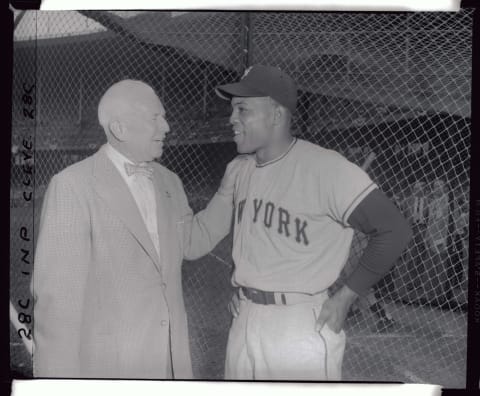
A Dynasty Rising
When the greatest teams of all time are talked about, the 1929 Athletics eventually come into the conversation. But in 1928, they still needed to rid themselves of such older players as Cobb, Speaker, and Collins so they could focus on their youth movement, exemplified by Simmons.
Still, their veteran leadership if not always actual play led them to overtake the stumbling Yankees, as Charlie Gentile synopsizes in his book, The 1928 Yankees: The Return of Murderer’s Row:
In spite of holding a commanding fourteen game edge over the second place Philadelphia Athletics midway through the season, the Yankees saw their lead disappear with just three weeks remaining. Manager Miller Huggins pulled together his patchwork pitching staff and banged-up regulars and reserves to mount a nail-biting fight to the finish.
To get there, they were going to have to face the A’s one last time. Only this match was in the Bronx.
History Repeats Itself
By September 9, in a New York doubleheader between the two teams, the A’s had moved into first place by half a game. There were 8,000 standing room only tickets put on sale that day; 25,000 people tried to buy them. Special police units had to be called in to quell the bedlam. Attendance was quoted as 85,265. (Yankee Stadium had been enlarged in the off-season.) The Yanks swept Philadelphia that day, and after an off-day Ruth untied the next game in the eighth with a two-run homer off supreme hurler Lefty Grove. The New York Times said, “It was the Ruth, the whole Ruth, and nothing but the Ruth at Yankee Stadium yesterday.” Even though the race wasn’t technically over, the Philadelphia spirit was crushed. The Yanks ended the season 21/2 games in front.
All That’s Left is the Waiting
This one last additional note of how Ruth finished the season demands to be included here:
However, once those games were played, Ruth stopped hitting entirely. Historian Lee Allen described the scene perfectly: “A large man in a camel’s-hair coat and camel’s-hair cap, standing in front of a hotel, his broad nostrils sniffing at the promise of the night.” Manager Miller Huggins considered another severe suspension and fine, but rethought it when he realized he would be laughed at. His team was in first place, after all.
Perhaps Ruth lost interest after the meaningful A’s series, or perhaps he just went into a slump. Or a bottle. Either way, when the season ended with a return to the WS clinched, the first of two big Yankees parties started:
The pennant-clinching celebration in Detroit was riotous. Ruth wanted a piano, but the hotel couldn’t find one. So the Babe bought one and had it delivered.
The Babe’s bat would awaken, however, just in time to find revenge for a World Series defeat. In the process, he created legends both remembered and forgotten.
And all of them bigger than life.

Tournament of Champions
It was to the surprise of no one that the Cardinals met the Yankees in the 1928 World Series. They were after all the last two WS Champions.
It was even this same bunch from St. Louis that had beaten the Yanks two years earlier in the ’26 Series. And they did so in spite of Ruth becoming the first player ever to hit three home runs in one WS game.
Now he and the Yankees wanted payback. They were well equipped to get it, too, after the season they had. In honor of the excellent work Andrew Mearns did for Pinstripe Alley, I will not pretend I did anything more than read what he wrote:
Babe Ruth and Lou Gehrig both played in every one of the Yankees’ 154 games. The “Sultan of Swat” led baseball in several offensive categories, posting truly ridiculous numbers: .323/.463/.709 with 54 homers, 380 total bases, 137 walks, a 206 OPS+, and 10.1 rWAR. Gehrig [hit] .374/.467/.648 with 47 doubles (best in the league), 13 triples, 27 homers, 364 total bases, a 193 OPS+, and 9.4 rWAR (second to Ruth).
It Takes More than Just Two
Beyond the two legends, the lineup was dominant, featuring tremendous seasons from Tony Lazzeri (145 OPS+), Bob Meusel (45 doubles), and Earle Combs (a league-best 21 triples), just to name a few. The offense led the league in each triple slash category, notching a .295/.365/.450 line with a 115 team OPS+. George Pipgras led the league with 300 2/3 innings pitched while finishing with a 112 ERA+ and 3.21 FIP. Hall of Famers Waite Hoyt and Herb Pennock were as reliable as ever, as Hoyt threw 273 innings of 113 ERA+ ball, and Pennock led the league with five shutouts, ended with a 149 ERA+ and a 3.10 FIP, and finished fourth in the league in rWAR with 5.8. The staff’s 3.74 ERA was the second-best mark in the league.
But although the final numbers were great, the season had been up and down, including the late-season slump by Ruth. Those factors combined to make the Cardinals favorites to win, 6-5.
What the odds-makers didn’t know, however, was how much impact a new manager can have.
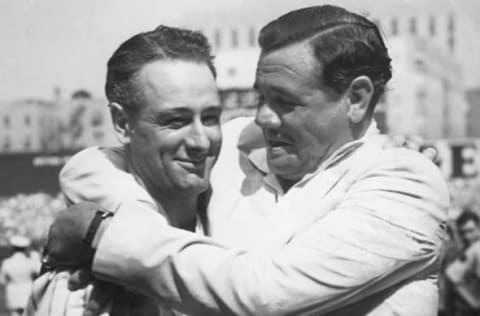
Rookie Manager
By the ’28 series, Bill McKechnie had replaced Rogers Hornsby as A’s manager; the results proved disastrous.
The difference between the 1926 Cardinals and their 1928 counterpart was one of managerial philosophy. While Rogers Hornsby had decided to keep the ball away from Ruth, walking him 11 times, McKechnie favored pitching to the big guy. It was a major tactical mistake. In the first three games, the Yankees outscored the Cardinals 20-7. Ruth had seven hits and had scored six runs.
The Yanks took the first two at home and then the series shifted location. But not momentum.
The Yankees would carry a 2-0 lead to Sportsman’s Park in St. Louis, where they had so often thumped the hapless AL St. Louis Browns. The Cardinals briefly led when Bottomley lined a two-run triple to center off Tom Zachary (starting in place of the injured Pennock), but Gehrig led the charge back against Haines with a solo homer over the right field fence in the second and a two-run inside-the-park job to deep center that scored Ruth (who had singled), and gave the Yankees a 3-2 lead. Andy High hit an RBI double in the fifth to tie it up, but the Yankees notched three runs in the sixth, highlighted by Meusel’s steal of home, to re-take the lead. Ruth added an RBI single in the seventh, and Zachary matched his rotation-mates by also completing what he started.
All Over But the Crying
By the end, it was clear to everyone that the oddsmakers were wrong. And in game four, Babe Ruth was going to make sure of it. Before he could though, this was the last part of the pre-game ceremonies that day.
But the grand climax of the antebellum ceremonies came when Alt-Rock gathered the band in centre field and then paraded up to the home plate with the band playing “Sidewalks of New York” at his heels and a brown derby on his head.
Once that was done, so were the Cards.
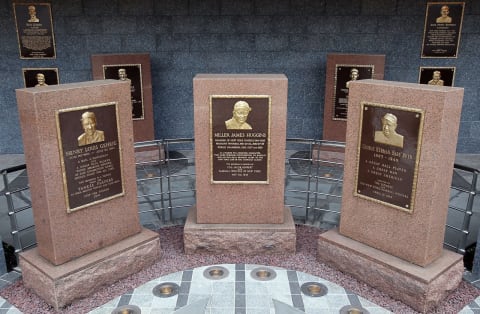
A Fine Review
Alan Gould started his contemporaneous recap of game four for the Associated Press this way:
The Yankees said it with home runs today and brought the 1928 World’s Series to a crashing, record-busting conclusion with their fourth straight triumph over the Cardinals. Five cracking circuit clouts, three of them by the one and only Babe Ruth, four of them in two successive innings and all of them death-sounding blows for the Redbirds enabled the Yankees to win by the decisive count of 7-3 and record a new World’s Series achievement by making their second consecutive clean sweep over National League champions.
There are interesting links to both the 1978 team and the current one here. As noted earlier, Ruth and the Yankees seemed to score late in games when they needed to, and their clutch play propelled them to ultimate victory. Yankees fans have seen that a lot lately.
Here’s Something They Haven’t Seen in a While
But the similarities to Reggie Jackson in the ’78 series really stand out. Both men hit three home runs in one WS game each; a feat only accomplished two other times. And one of those was by Ruth two years earlier in the same building he now stood in.
Both also hit home runs in back-to-back innings, as well as in their respective eighth innings. And both helped the Yankees win by four runs in decisive games; the 1978 Yankees won game six, 8-4.
However, while Ruth was the star of the game, he and Gehrig were the equal stars of the series. Their stats speak for themselves:
1B Lou Gehrig, .545/.706/1.727, 6-for-11, 2B, 4 HR, 6 BB, 2.433 OPS RF Babe Ruth, .625/.647/1.375, 10-for-16, 3 2B. 3 HR, BB, 2.022 OPS
Impressive; almost as impressive as how Ruth hilariously handled the pivotal moment in this World’s Series game. And then buried the Cardinals.
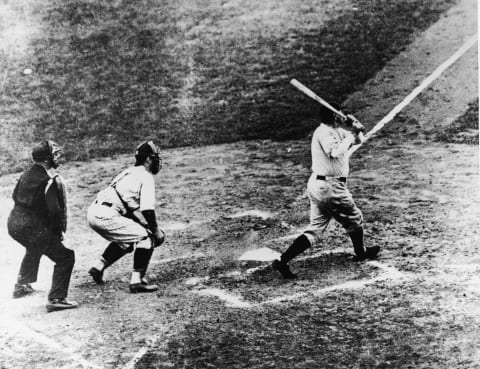
There’s Always a Pivotal Moment
I can think of no better way of highlighting all parties involved than quoting liberally from that same first-hand account about this most interesting interlude.
The drama of the whole game turned upon Ruth in the seventh inning in remarkable fashion at a time when the Yankees punch was conspicuous by its absence and when the Cardinals were holding tenaciously to a one-run lead. One strike was called, then a second on a floater that Babe let go by. Ruth shifted his stance, looked up at the scoreboard, and as he did so, [pitcher] Sherdel whipped another ball that cut the heart of the plate. It was a smart play, but Umpire Pfirman had raised his arms to indicate suspension of play… Sherdel, incensed to high pitch, rushed in to protest followed by Captain Frisch and the rest of the Cardinals.
The Real Called Shot
But Ruth—the biggest instigator in history—could never be satisfied with just causing chaos in the middle of a World Series.
Several loud debates with the umpires roared around the field. Babe walked around the arguing clusters of men with a broad grin on his face.
Order was finally restored, however; at least to Yankees universe.
Once they settled down, he did something he would be given more credit for a few years later. Ruth barked at Sherdel, “Put one right here and I’ll knock it out of the park.” Sherdel took the bait. Ruth hit the ball over the rightfield pavilion. Gehrig followed with another homer, and the Yanks put up two more runs before the inning was over. They added another deuce in the eighth off old-timer Pete Alexander, propelled by Ruth’s third homer of the game.
Afterward, when Ruth returned to the St. Louis outfield, the crowd greeted him in an old-fashioned baseball tradition.
So aroused had the bleacher crowd become after that fateful seventh…that Ruth was the target for a mild shower of pop bottles… Three of the missiles landed within a few feet of the Babe, who threw them from the field.
However, the damage had been done, and the series was now destined to be won by the Yankees. But how they won it and how they celebrated still resonates in Yankees lore.

Eat Your Heart Out, Billy Martin
With the Yankees holding a five-run lead going into the bottom of the ninth, Ruth took his place in left field, a position he played in his career almost as much as right. The A’s made some noise but with two on and two outs,
The game belonged to the Babe. So he decided to end it with a final Ruthian fillip. The Cards scored once in the last of the ninth and had two men on when Frank Frisch lofted a foul fly down the leftfield line. Ruth charged over and snagged the ball on a dead run before it could fall into the temporary seats. Then he held it proudly aloft for all to see as he hustled into the dugout.
It was by all accounts an amazing catch, even if one of those accounts is Ruth’s own. And his manager’s.
Ruth thundered into the clubhouse with his gloved right hand still held aloft clasping that ball as he raced across the field…despite a shower of torn paper calculated to interfere. He was perspiring and panting, but he was never more joyous. “There’s the ball that say’s it’s all over,” he said, “there it is, right where I grabbed it out of the air. What a catch. Boy, wasn’t I glad to get my hand on that ball.” The joy of Ruth…was rivaled by that of Manager Huggins over the same play. Smiling and singing and drawing deep puffs on the smoke scarred pipe that is part of him, Huggins repeated over and over again, “Did you ever see such a finish to a ball game? What a catch, what a catch.” Tears formed in the eyes of the mite manager…; Huggins was tremendously happy.
That’s What Makes a Legend
There is no video of the catch, and so it lives only in Yankees lore. But it remains a feat Ruth himself valued over his three home-run day.
With that catch, the series was concluded with a sweep. And the Yankees had simultaneously become the first team to repeat as WS champions, something the ’27 team never had the chance to do.
Once in the visitor’s locker room, his cheering teammates went wild and celebrated as teams hot from the battle often do. And thinking back to the pre-game, the Babe then led them in song.
The Yankees were celebrating in their dressing quarters…like men possessed, they were cuffing each other about, slapping bare backs as uniforms were doffed and the rush was on for the cooling showers. Suddenly out of the commotion came a leader’s voice, with, “East side, west side, all around the town” and in the wink of an eye, the disorganized celebration was transformed into a disorganized, inharmonious outburst of vocal effort in which even Manager Miller Huggins was heard to join. And the song didn’t break until it had run its complete course when the final note was supplied by the booming voice of Babe Ruth.
The singing was so loud it rang out into the stadium and right into the home locker room, one last taunt in victories revenge.
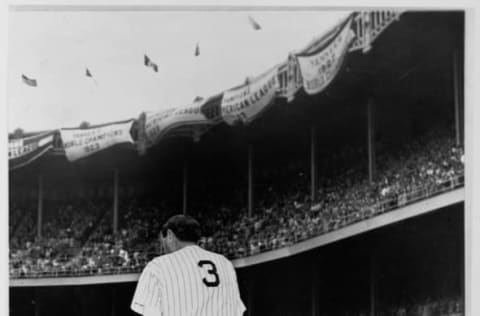
A Man is Never Dead as Long as He is Remembered
This being the Babe, though, whose motto was Too Much is Never Enough, he made sure there’d be no sleep till the Bronx.
Ruth kept the train from leaving the station until he was sure there were enough supplies for the party to come en route, including four bushels of spare ribs. All the way from St. Louis to New York that night, whenever the train passed through a small town, throngs of people gathered and cheered to see the Babe. He made dozens of appearances from the back of the train on the way home, with varying degrees of politeness. The crowds loved it anyway.
There you have it. Only in Yankees lore could a forgotten championship team feature Hall of Famers, an actual called shot, a WS feat only done four times in history, and oversized Ruthian glories.
Next: See the Yankees Four Greatest Teams that Never Were
Next time we will move up a decade to the ’38 team, and the next New York Yankees superstar, Joltin’ Joe DiMaggio. And maybe someday we might even have to include the 2018 team on this list.
But no matter how many homers they hit, or opponents hearts they rip out, it would be nigh impossible to live up to Babe Ruth and the legendary 1928 Yankees.